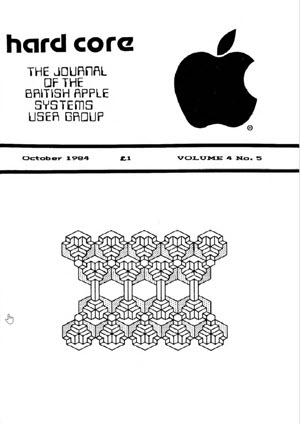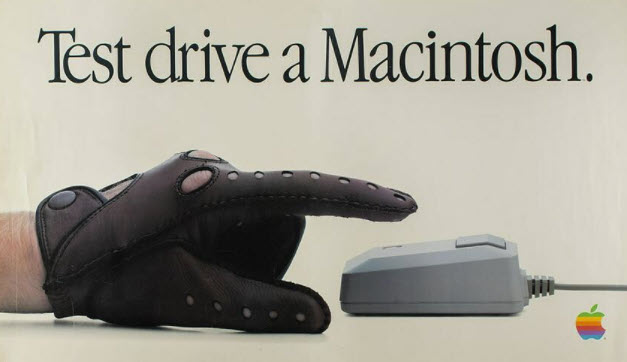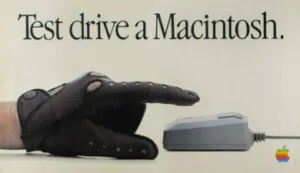Today, I’m going to get away from the techie details that I love so much and indulge myself by talking about the Apple Mac and the way that Apple seems to have re-discovered its Mac mojo since the launch of its own silicon. Given that Apple has always been about innovation and new ideas, it’s arguably slightly strange that the Mac concept is nearly 40 years old.

 My own history of contact with the Mac is a long way, although mostly at a distance. Back in the early ’80s and before the Mac, as an Apple ][ fanatic, I was chairman of the British Apple Systems User Group, or BASUG and my first exposure to periodical publishing was because my wife was editing ‘Hard Core’, the monthly magazine. It was all done with a daisywheel printer and Letraset on the dining room table (if you don’t know what Letraset is, ask your parents or look here. I’m sure I still have some sheets here, somewhere…). A dig around the internet found almost the last issue that she edited in 1984 here. (Reading it again after all this time, I really enjoyed a piece I wrote that made a plea for ‘more user hostility’…
My own history of contact with the Mac is a long way, although mostly at a distance. Back in the early ’80s and before the Mac, as an Apple ][ fanatic, I was chairman of the British Apple Systems User Group, or BASUG and my first exposure to periodical publishing was because my wife was editing ‘Hard Core’, the monthly magazine. It was all done with a daisywheel printer and Letraset on the dining room table (if you don’t know what Letraset is, ask your parents or look here. I’m sure I still have some sheets here, somewhere…). A dig around the internet found almost the last issue that she edited in 1984 here. (Reading it again after all this time, I really enjoyed a piece I wrote that made a plea for ‘more user hostility’…
(I had forgotten that, in that issue, I also wrote a review of the Greengate DS:3 music sampler – one of the first of that category of instruments to be designed and was created by members of the Club.)
Anyway, back to the Mac. As chairman of the group, I got an invitation to the European launch of the Mac in London in early 1984. My memories of the event are pretty vague, these days, but I do remember someone walking onto the stage holding one. It looked very small, as indeed it was. I was working for a company that distributed peripherals for computers (including the monitors – which I started to get very interested in) that also had an Apple dealership. (It had been the importer of Apple computers into the UK before Apple set up its own subsidiary). Apple ran a ‘Test Drive a Macintosh’ campaign, so I did. I liked it, but not enough to buy one. In the early days there was little software and they weren’t cheap.
 Mac test drive posters now sell at auction as art!
Mac test drive posters now sell at auction as art!
The other problem was that, by now, the IBM PC was well established and that was the market for the peripherals that I was promoting. In the UK, the BBC Model B microcomputer was also very important for peripheral sales. In contrast, the Mac system was very closed and you really need Apple’s own peripherals. So I drifted away from Macs to PCs.
For a while, when the Mac II came along with colour graphics and slots for peripheral cards, I worked with US companies (mainly eMachines, iirc) to develop and market a plug in board that worked will with the monitors that I was then completely involved in. That was almost my last involvement and although I have reported on Mac product launches (and attended a number in Paris and London), I haven’t really used one since.
Motorola Chips
The early Macs were built on Motorola 68000 series chips, which Apple had used in the Lisa, its first ‘GUI-based computer’ having used the MOS 6502 in the Apple ][*. That chip was based on the Motorola 6800 design. The Mac // used the 68020.
In 1994, with Motorola chip performance suffering compared to Intel’s CPUs which were now at the 486 level, Apple went for the PowerPC architecture, developed by themselves, IBM and Motorola and based on RISC architecture. That architecture was used to power all the Mac products, including the iMac and MacBooks, but that changed in 2006, when Apple adopted Intel chips for OS X, partly because of the lower power consumption that they had that allowed more powerful notebook PCs.
Back in 2016, Bloomberg’s Apple watcher, Mark Gurman wrote an article that opened with the line that
“To die-hard fans, Apple Inc.’s Macintosh sometimes seems like an afterthought these days.”
However, after more than a decade of using Intel chips, Apple announced in 2020 that it would switch a lot of products to its own chips based on an ARM architecture and that has really changed that perception.
The M1 Cavalry Arrives
The new M1 chip came out to much acclaim at product launches in November 2020, with the MacBook Air, the 13” MacBook Pro, and the Mac Mini. Since then, the more powerful M1 Pro and M1 Max chips have been added. Apple does still use Intel CPUs in its 27″ iMac and Mac Pro PCs, where power efficiency is less of an issue.
Of course, the silicon is important, but so is the Mac operating system. A dig into that is beyond this article, but if you wonder why it is important, I wrote about this in an article that explains its appeal here. On the Horns of a Trilemma!.
Anyway, the M1 chips have really boosted the status and performance of Mac systems and as a result they have started to grow in sales again, which is what provoked the idea for this article. My favourite photography hardware site, DPReview.com, talking of the latest MacBook Pro machines described them as having ‘performance-per-watt into the stratosphere’.
As Mark Gurman of Bloomberg said in his subscription newsletter,
“From fiscal 2011 through 2020, the Mac generated around $21 billion to $28 billion per year. In 2021? A cool $35 billion—even more than the iPad”.
 Statista compiled the data in the chart, but we re-drew it and added some trend linesIn fact, the revenues from the Mac range of products were 8.8% of all Apple’s sales compared to just 5.8% from the iconic iPad. The sales in fiscal Q1 2022 were also a new record for Apple at $10.85 billion, the first time that the $10 billion level was reached.
Statista compiled the data in the chart, but we re-drew it and added some trend linesIn fact, the revenues from the Mac range of products were 8.8% of all Apple’s sales compared to just 5.8% from the iconic iPad. The sales in fiscal Q1 2022 were also a new record for Apple at $10.85 billion, the first time that the $10 billion level was reached.
Of course, the world of semiconductors moves rapidly. This year, Apple watchers expect a new M2 chip for Pro and Mac Mini models as well as the iMac 24″, watch out for news at the developers’ event in the summer.
Personally, I can see myself getting back into the Apple world as my need for lots of business software has declined and more and more of the applications that I use go to the cloud. I have an iPad Pro that uses the M1 chip and the performance is impressive (even if the iPad with its Magic Keyboard – magic because it makes Apple so much profit – weigh more than my high end notebook!) (BR)
(* In my early days with the Apple ][, I designed a sound board for it – you could do it in those days just with the owners manual and I’m renowned in the family for having spent much of a family holiday in a tent in France working my way through ‘Programming the 6502‘ by Rodney Zaks)

